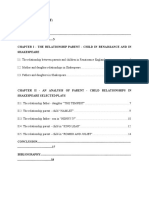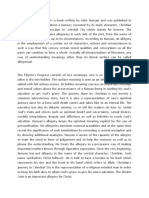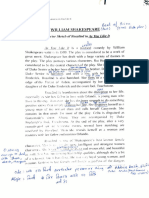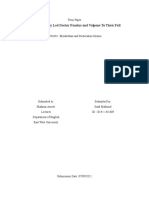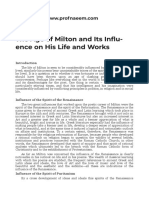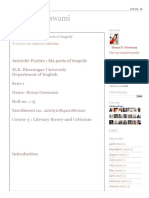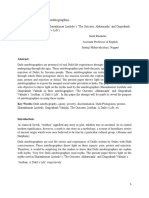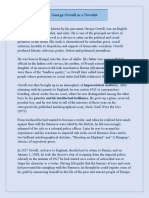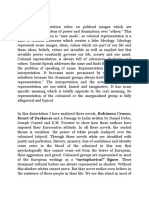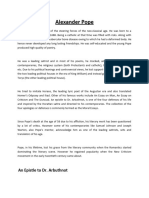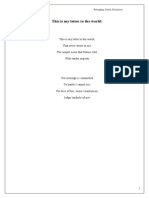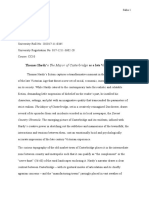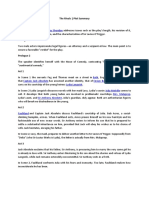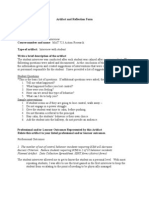Pamela novel
Uploaded by
خالد الغيثيPamela novel
Uploaded by
خالد الغيثيPAMELA NOVEL
1- The Novelist: Samuel Richardson:
Samuel Richardson (1689–1761) stands as one of the foremost pioneers
of the modern English novel. His contribution to the literary world is
unparalleled, as he helped to shape the novel into a form that could
explore human emotions, moral dilemmas, and social issues with depth
and sophistication. Richardson’s life story is as fascinating as his works,
reflecting the values of perseverance, dedication, and a commitment to
education.
Early Life and Humble Beginnings
Richardson was born into a large family in Derbyshire, England. His
father, a joiner, provided a modest income, and the family faced
economic difficulties throughout Richardson’s childhood. Despite these
challenges, young Samuel exhibited a natural aptitude for storytelling
and learning. Unlike many of his peers
Richardson’s personal life also influenced his writing. Married twice and
the father of six children, most of whom died in infancy, Richardson
experienced both the joys and the sorrows of family life. These personal
tragedies shaped his sensitivity to human suffering and his ability to
portray emotional depth in his characters. His own experiences of loss
and perseverance made him particularly attuned to themes of virtue,
resilience, and the moral struggles of ordinary people.
In his professional life, Richardson’s success as a printer earned him
widespread respect. His reputation for diligence and honesty attracted
influential clients, including the House of Commons. This professional
stability gave him the freedom to experiment with writing in his later
years. His transition to fiction writing was not a rejection of his trade but
rather an extension of his creativity, as his deep familiarity with the
written word gave him the tools to construct narratives with precision
and elegance.
Famous Works
In addition to Pamela, Samuel Richardson wrote other significant works
that further solidified his reputation as a masterful storyteller:
1. Clarissa, or the History of a Young Lady (1747–1748): This
monumental work is widely considered Richardson’s masterpiece. At
over a million words, it remains one of the longest novels in English
literature. Clarissa delves deeply into themes of love, coercion, and
moral conflict, portraying the tragic downfall of a virtuous young
woman.
2. The History of Sir Charles Grandison (1753–1754): In this novel,
Richardson explores themes of honor, marriage, and social duty
through the character of Sir Charles Grandison, an ideal gentleman.
The work is seen as a response to the darker, tragic themes of Clarissa
and offers a more optimistic vision of virtue and morality.
3. Familiar Letters on Important Occasions (1741): This is a
collection of letters written as a guide for young people on how to
navigate relationships, business, and moral issues. The work reflects
Richardson’s belief in the power of correspondence as a medium for
personal growth and ethical development.
4. A Collection of Moral Sentiments and Maxims: Richardson
compiled this work to provide readers with moral guidance and
philosophical reflections on human nature, virtue, and society. Though
less known than his novels, it reveals his deep concern for morality
and ethics.
5. Aesop’s Fables in English and Latin: This work is a translation
project Richardson undertook to make Aesop’s timeless fables
accessible to a broader audience. While it is not an original creation, it
showcases his dedication to moral storytelling and education.
Pamela: A Groundbreaking Achievement
Richardson’s first novel, Pamela, was revolutionary in its time. Published
in 1740, it marked a departure from the fantastical romances and heroic
epics that dominated earlier literature. Instead, Richardson focused on
the everyday struggles of a young servant girl, elevating her story into a
moral and emotional journey that resonated with readers across social
classes.
The novel’s subtitle, Virtue Rewarded, encapsulates its central theme:
the triumph of morality and integrity over adversity. Pamela’s
unwavering commitment to her principles, even in the face of temptation
and coercion, serves as both a lesson and an inspiration. This emphasis
on moral virtue aligned with the values of Richardson’s time, but it also
challenged societal norms by suggesting that virtue was not exclusive to
the upper classes.
The Epistolary Style and Psychological Realism
Richardson’s use of the epistolary format was a groundbreaking
narrative technique. By presenting the story through Pamela’s letters
and journal entries, Richardson gave readers a direct window into her
thoughts, fears, and hopes. This approach allowed him to explore
psychological realism in unprecedented detail. Readers were not just
observing Pamela’s actions; they were experiencing her inner struggles
and emotional growth alongside her.
The epistolary style also created an intimate connection between the
protagonist and the audience. Pamela’s candid reflections made her
relatable and human, while the immediacy of her writing heightened the
suspense and emotional impact of the story. This innovative technique
set a new standard for character development and narrative depth,
influencing countless authors who followed.
Criticism and Controversy
Despite its popularity, Pamela was not without its critics. Some readers
found the novel’s moral tone overly didactic, while others questioned the
plausibility of Mr. B’s transformation from a predatory aristocrat to a
repentant husband. Critics like Henry Fielding, a contemporary of
Richardson, even satirized the novel in works such as Shamela, which
mocked Pamela’s piety and suggested that her virtue was a calculated
ploy.
These critiques, however, did little to diminish Pamela’s impact. If
anything, the debates it sparked only underscored its significance. By
addressing issues of virtue, power, and social mobility, Richardson had
touched on themes that were both universal and deeply relevant to his
time.
Richardson’s Role as a Moral Educator
Richardson did not view himself solely as a storyteller; he saw his novels
as tools for moral instruction. In the preface to Pamela, he described his
intention to “cultivate the principles of virtue and religion in the minds of
the youth of both sexes.” His works reflect this didactic purpose,
blending entertainment with lessons about integrity, perseverance, and
the consequences of one’s actions.
This moral focus was particularly significant in the context of 18th-
century England, a society that placed great emphasis on propriety and
virtue. Richardson’s portrayal of Pamela as a model of moral excellence
resonated with readers who were grappling with questions about
personal ethics and social responsibility.
Literary Influence and Legacy
Richardson’s influence on the novel as a literary form cannot be
overstated. By combining emotional depth with social commentary, he
demonstrated the potential of the novel to engage with complex ideas
and evoke profound responses from readers. His emphasis on
psychological realism laid the groundwork for later writers such as Jane
Austen, who admired Richardson’s ability to capture the subtleties of
human relationships.
Moreover, Richardson’s exploration of gender dynamics and power
structures remains relevant today. His portrayal of Pamela’s struggle
against Mr. B’s advances highlights the vulnerabilities faced by women in
a patriarchal society, while her eventual triumph serves as a powerful
affirmation of female agency and resilience.
Even in modern literary studies, Richardson’s works continue to be
analyzed for their
themes, narrative techniques, and cultural significance. Pamela, in
particular, is recognized as a foundational text in the development of the
English novel, offering insights into both the literary innovations of the
18th century and the enduring complexities of human nature.
2. Summary of the Novel: Pamela, or Virtue Rewarded
Samuel Richardson’s Pamela, or Virtue Rewarded, published in 1740, is
widely regarded as one of the first English novels to combine moral
instruction with compelling
storytelling. The narrative follows the life of Pamela Andrews, a young
servant girl, and her struggles to protect her virtue in the face of
relentless challenges posed by her wealthy and powerful master, Mr. B.
Written in an epistolary style, the novel is told through Pamela’s letters
and journal entries, offering an intimate view of her thoughts and
emotions.
The Beginning: Pamela’s Situation
The story begins with the death of Lady B, Pamela’s kind and generous
employer. Lady B had treated Pamela with great care, providing her with
an education and instilling in her a strong sense of morality. After her
death, Pamela continues working in the household, now under the
supervision of Lady B’s son, Mr. B.
At first, Mr. B appears to take an interest in Pamela’s well-being, offering
her gifts and compliments. However, his intentions soon become clear.
He attempts to seduce her, using his position of power to pressure her
into a relationship. Pamela, a deeply religious and principled young
woman, refuses his advances, valuing her virtue above all else.
Pamela’s Struggles and Mr. B’s Schemes
Mr. B’s initial attempts to win Pamela over are subtle, involving flattery
and promises of wealth. When these fail, he resorts to more aggressive
tactics. He begins to spy on her, intercepts her letters to her parents, and
even abducts her, confining her to his remote estate.
During her imprisonment, Pamela remains steadfast in her
determination to resist Mr. B’s advances. She documents her experiences
in letters and journals, which serve as both a source of comfort and a
means of communicating her plight to the outside world. Despite her fear
and despair, Pamela clings to her faith and her belief in the importance of
moral integrity.
The Turning Point: Mr. B’s Transformation
As the story progresses, a surprising transformation begins to take place.
Mr. B, initially portrayed as a predatory and unscrupulous figure, starts
to change. He is moved by Pamela’s unwavering virtue, her intelligence,
and her ability to remain kind and forgiving despite his mistreatment.
Eventually, Mr.B expresses genuine remorse for his actions and
confesses that he has fallen in love with Pamela. He proposes marriage,
offering her the respect and social position that she deserves. Pamela,
after much reflection and consultation with her family, agrees to marry
him, believing that he has truly reformed.
The Resolution: Virtue Rewarded
The latter part of the novel focuses on Pamela’s new life as the wife of a
wealthy gentleman. Despite her elevated status, she remains humble and
continues to prioritize her faith and principles. Her marriage to Mr. B
serves as a resolution to the central conflict of the story, symbolizing the
triumph of virtue over vice.
Pamela’s journey from a lowly servant to a respected wife is portrayed as
a reward for her steadfast commitment to her values. The novel
concludes with a sense of moral vindication, as Pamela’s virtue not only
wins her personal happiness but also inspires those around her.
Themes and Moral Lessons
Pamela, or Virtue Rewarded is more than just a story of love and
marriage; it is a commentary on the social and moral values of the time.
The novel explores themes such as:
• The Power of Virtue: Pamela’s steadfast morality is central to the
story, demonstrating that virtue can triumph over adversity.
• Class and Social Mobility: Pamela’s rise from servant to
gentlewoman challenges the rigid class structures of 18th-century
England.
• Gender and Power Dynamics: The novel highlights the
vulnerability of women in a patriarchal society, while also celebrating
Pamela’s agency and resilience.
Reception and Impact
The novel’s conclusion, in which Pamela’s virtue is rewarded with love,
respect, and social elevation, was both celebrated and criticized by
readers. Some saw it as a powerful affirmation of moral values, while
others questioned the plausibility of Mr. B’s transformation and
criticized the novel’s emphasis on submission and forgiveness.
Despite these debates, Pamela remains a groundbreaking work, paving
the way for the development of the modern English novel.
3. My Opinion About the Novel: Pamela, or Virtue
Rewarded
When I first read Pamela, or Virtue Rewarded, I was struck by how
unique and revolutionary it must have been for its time. Personally, I
admire Samuel Richardson’s ability to craft a story that not only
entertains but also teaches important lessons about morality,
perseverance, and faith. The novel’s focus on Pamela’s inner struggles
and her unwavering commitment to her principles made a lasting
impression on me.
What I Admire About the Novel
One of the aspects I truly appreciate is Pamela’s character. She
represents strength, resilience, and self-respect in the face of immense
challenges. I think her journey is not just about protecting her virtue, but
also about staying true to her values and beliefs in a world that
constantly tests them. Pamela’s humility and determination remind me
of the importance of holding onto one’s principles, even when it’s
difficult.
Another thing I find remarkable is how Richardson uses the epistolary
format to tell the story. Through Pamela’s letters and journal entries, I
felt like I was right there with her, experiencing her fears, hopes, and
joys. This style made the novel feel very personal to me, as if Pamela
herself were confiding in me. It’s rare to find a book that creates such a
close connection between the character and the reader, and I think this is
one of Richardson’s greatest achievements.
Themes That Resonated With Me
The novel’s exploration of virtue and morality resonated deeply with me.
I believe Richardson’s message about the value of integrity and the
strength it takes to resist temptation is still relevant today. In our
modern world, where people often face moral compromises, Pamela’s
story serves as a reminder that staying true to oneself is always worth it.
I also found the themes of social class and mobility thought-provoking.
Pamela’s rise from a servant to a gentlewoman challenges the idea that a
person’s worth is tied to their social status. For me, this theme feels
empowering because it shows that character and virtue are what truly
define a person, not their background or wealth.
Criticisms and Mixed Feelings
While I admire many aspects of the novel, I also have some mixed
feelings about certain parts. For example, I found Mr. B’s initial behavior
toward Pamela extremely troubling. His attempts to manipulate and
control her made me uncomfortable, and at times, I questioned whether
his eventual transformation was believable. I think Richardson could
have spent more time showing the process of Mr. B’s change, so it felt
more gradual and realistic.
Another issue I struggled with was Pamela’s quick forgiveness of Mr. B.
While her capacity for forgiveness is admirable, I sometimes felt that she
was too forgiving, considering the way he treated her earlier in the story.
I wondered if this was Richardson’s way of emphasizing Pamela’s virtue,
or if it reflected the expectations of women during that time period.
What I Learned From the Novel
Despite these criticisms, I think Pamela has a lot to teach readers. The
novel reminded me of the importance of self-respect and standing firm in
one’s values. Pamela’s story shows that even in the most difficult
situations, it’s possible to maintain dignity and grace.
The novel also made me think about the power of storytelling. Through
her letters, Pamela not only documents her experiences but also
transforms them into a source of strength. This idea of using writing as a
way to process emotions and overcome challenges is something I find
inspiring.
My Overall Impression
In my opinion, Pamela is a powerful and thought-provoking novel that
deserves its place in literary history. While it has its flaws, its strengths
far outweigh them. I think Richardson’s ability to create a story that
combines emotional depth with moral lessons is truly impressive.
Reading Pamela was a rewarding experience for me. It challenged me to
think about my own values and beliefs, and it reminded me of the
importance of resilience and faith in the face of adversity. For these
reasons, I would recommend it to anyone who enjoys stories that are
both meaningful and engaging.
Conclusion
Samuel Richardson’s Pamela, or Virtue Rewarded is undoubtedly a
groundbreaking work that has earned its place in literary history. As one
of the earliest novels to explore complex human emotions through an
intimate narrative style, it set the stage for the modern novel.
Richardson’s portrayal of Pamela as a virtuous, resilient character
highlights timeless values such as integrity, faith, and the strength of the
human spirit.
Through Pamela’s journey, readers are invited to reflect on important
themes such as morality, social mobility, and the dynamics of power and
gender. The story also emphasizes the transformative potential of love
and redemption, even in the most unlikely circumstances.
While the novel has its flaws—such as the questionable portrayal of Mr.
B’s sudden transformation—its overall message about the triumph of
virtue remains impactful. Personally, I found Pamela’s determination and
unwavering principles to be truly inspiring. Her ability to navigate
adversity with grace and conviction is a lesson that transcends the
boundaries of time and culture.
In conclusion, Pamela is more than just a story; it is a moral and
emotional exploration that challenges readers to think about their own
values and choices. Whether one agrees with all aspects of the narrative
or not, it is impossible to deny the novel’s enduring relevance and its
contribution to the development of literature.
You might also like
- Thesis - The Relationship Between Parents and Children in Shakespeare Selected Plays60% (5)Thesis - The Relationship Between Parents and Children in Shakespeare Selected Plays20 pages
- Constitution and By-Laws of The Senior High School100% (2)Constitution and By-Laws of The Senior High School5 pages
- "Michael" and The New Realistic PastoralNo ratings yet"Michael" and The New Realistic Pastoral10 pages
- The Way of The World As A Comedy of Manners - ENotes100% (2)The Way of The World As A Comedy of Manners - ENotes2 pages
- Saad Mahmud - How Blasphemy Led Doctor Faustus and Volpone To Their FallNo ratings yetSaad Mahmud - How Blasphemy Led Doctor Faustus and Volpone To Their Fall8 pages
- ILLL Samuel Johnson Priyadarshini 13 Oct PDF100% (1)ILLL Samuel Johnson Priyadarshini 13 Oct PDF19 pages
- Working Class Women's Appeal To Aristocrats in She Stoops To Conquer PDFNo ratings yetWorking Class Women's Appeal To Aristocrats in She Stoops To Conquer PDF14 pages
- Barrenness of Imaginative Faculty (Easier Translation)100% (1)Barrenness of Imaginative Faculty (Easier Translation)6 pages
- An Analysis and Interpretation of Keats Endymion PDFNo ratings yetAn Analysis and Interpretation of Keats Endymion PDF241 pages
- The Age of Milton and Its Influence On His Life and Works - NeoEnglish100% (1)The Age of Milton and Its Influence On His Life and Works - NeoEnglish3 pages
- Aristotle's Poetics-Six Parts of TragedyNo ratings yetAristotle's Poetics-Six Parts of Tragedy15 pages
- The Countess Cathleen A Play by William Butler Yeats100% (1)The Countess Cathleen A Play by William Butler Yeats2 pages
- Bravely Fought The Queen - A Critical Overview: A Brief History of Indian English Drama100% (1)Bravely Fought The Queen - A Critical Overview: A Brief History of Indian English Drama9 pages
- Discussing Satire in The Beggars Opera English Literature EssayNo ratings yetDiscussing Satire in The Beggars Opera English Literature Essay2 pages
- Restoration Tragedy and Heroic Drama JohNo ratings yetRestoration Tragedy and Heroic Drama Joh16 pages
- Types of Intellectuals in Antonio Gramsci's The Formation of The IntellectualsNo ratings yetTypes of Intellectuals in Antonio Gramsci's The Formation of The Intellectuals3 pages
- CC10 - Thomas Hardy's The Mayor of Casterbridge As A Late Victorian NovelNo ratings yetCC10 - Thomas Hardy's The Mayor of Casterbridge As A Late Victorian Novel6 pages
- Henry Fielding's Comic Epic in Prose: A Study of Joseph Andrews in The Light of This GenreNo ratings yetHenry Fielding's Comic Epic in Prose: A Study of Joseph Andrews in The Light of This Genre3 pages
- Richard Brinsley Sheridan: The Rivals - Plot Summary PrefaceNo ratings yetRichard Brinsley Sheridan: The Rivals - Plot Summary Preface2 pages
- Dryden As The Father of English Criticism PDFNo ratings yetDryden As The Father of English Criticism PDF6 pages
- The Rival Ladies: "Look around the inhabited world; how few know their own good, or knowing it, pursue."From EverandThe Rival Ladies: "Look around the inhabited world; how few know their own good, or knowing it, pursue."No ratings yet
- Reading and Writing 1 Unit 7 Achievement Test100% (1)Reading and Writing 1 Unit 7 Achievement Test4 pages
- Dispositional Vs Situational AttributionNo ratings yetDispositional Vs Situational Attribution6 pages
- Online Examination Application System Rajiv Gandhi University of Health Sciences BengaluruNo ratings yetOnline Examination Application System Rajiv Gandhi University of Health Sciences Bengaluru1 page
- Beth Szwiec Resume Certified Teacher 3062016No ratings yetBeth Szwiec Resume Certified Teacher 30620162 pages
- Introduction To Employee Training and Development PPT 1No ratings yetIntroduction To Employee Training and Development PPT 18 pages
- Student Support Material English Core - Class Xii 2022-23No ratings yetStudent Support Material English Core - Class Xii 2022-23284 pages
- Lund University - Master Programme in AccountingNo ratings yetLund University - Master Programme in Accounting8 pages
- Course: Project Management Mesbaul Khair Chapter: 5 (Process of Planning Projects) ID: 3-11-21-082No ratings yetCourse: Project Management Mesbaul Khair Chapter: 5 (Process of Planning Projects) ID: 3-11-21-0823 pages
- Critical Approaches in Writing A CritiqueNo ratings yetCritical Approaches in Writing A Critique13 pages

